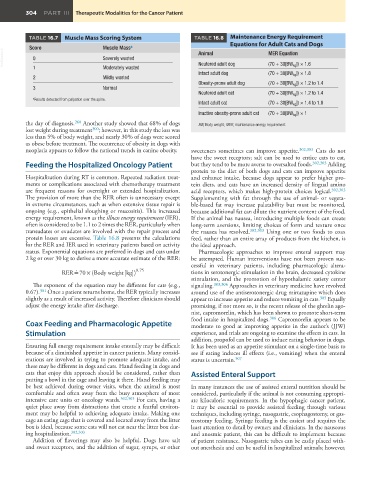Page 326 - Withrow and MacEwen's Small Animal Clinical Oncology, 6th Edition
P. 326
304 PART III Therapeutic Modalities for the Cancer Patient
TABLE 16.7 Muscle Mass Scoring System TABLE 16.8 Maintenance Energy Requirement
Equations for Adult Cats and Dogs
Score Muscle Mass a
VetBooks.ir 0 Severely wasted Animal MER Equation
Neutered adult dog
(70 + 30[BW kg ]) × 1.6
1
Moderately wasted
Intact adult dog (70 + 30[BW kg ]) × 1.8
2 Mildly wasted
Obesity-prone adult dog (70 + 30[BW kg ]) × 1.2 to 1.4
3 Normal
Neutered adult cat (70 + 30[BW kg ]) × 1.2 to 1.4
a Results detected from palpation over the spine.
Intact adult cat (70 + 30[BW kg ]) × 1.4 to 1.6
Inactive obesity-prone adult cat (70 + 30[BW kg ]) × 1
the day of diagnosis. 260 Another study showed that 68% of dogs BW, Body weight; MER, maintenance energy requirement.
lost weight during treatment 300 ; however, in this study the loss was
less than 5% of body weight, and nearly 30% of dogs were scored
as obese before treatment. The occurrence of obesity in dogs with
neoplasia appears to follow the national trends in canine obesity. sweeteners sometimes can improve appetite. 302,303 Cats do not
have the sweet receptors; salt can be used to entice cats to eat,
Feeding the Hospitalized Oncology Patient but they tend to be more averse to oversalted foods. 302,303 Adding
protein to the diet of both dogs and cats can improve appetite
Hospitalization during RT is common. Repeated radiation treat- and enhance intake, because dogs appear to prefer higher pro-
ments or complications associated with chemotherapy treatment tein diets, and cats have an increased density of lingual amino
are frequent reasons for overnight or extended hospitalization. acid receptors, which makes high-protein choices logical. 302,303
The provision of more than the RER often is unnecessary except Supplementing with fat through the use of animal- or vegeta-
in extreme circumstances, such as when extensive tissue repair is ble-based fat may increase palatability but must be monitored,
ongoing (e.g., epithelial sloughing or mucositis). This increased because additional fat can dilute the nutrient content of the food.
energy requirement, known as the illness energy requirement (IER), If the animal has nausea, introducing multiple foods can create
often is considered to be 1.1 to 2 times the RER, particularly when long-term aversions, limiting choices of form and texture once
transudates or exudates are involved with the repair process and the nausea has resolved. 302,303 Using one or two foods to coax
protein losses are excessive. Table 16.8 presents the calculations feed, rather than an entire array of products from the kitchen, is
for the RER and IER used in veterinary patients based on activity the ideal approach.
status. Exponential equations are preferred in dogs and cats under Pharmacologic approaches to improve enteral support may
2 kg or over 30 kg to derive a more accurate estimate of the RER: be attempted. Human interventions have not been proven suc-
cessful in veterinary patients, including pharmacologic altera-
0.75
RER ˙= 70 × (Body weight[kg]) tions in serotonergic stimulation in the brain, decreased cytokine
stimulation, and the promotion of hypothalamic satiety center
The exponent of the equation may be different for cats (e.g., signaling. 303,304 Approaches in veterinary medicine have revolved
0.67). 301 Once a patient returns home, the RER typically increases around use of the antiserotonergic drug mirtazapine which does
slightly as a result of increased activity. Therefore clinicians should appear to increase appetite and reduce vomiting in cats. 305 Equally
adjust the energy intake after discharge. promising, if not more so, is the recent release of the ghrelin ago-
nist, capromorelin, which has been shown to promote short-term
food intake in hospitalized dogs. 306 Capromorelin appears to be
Coax Feeding and Pharmacologic Appetite moderate to good at improving appetite in the author’s (JJW)
Stimulation experience, and trials are ongoing to examine the effects in cats. In
addition, propofol can be used to induce eating behavior in dogs.
Ensuring full energy requirement intake enterally may be difficult It has been used as an appetite stimulant on a single-time basis to
because of a diminished appetite in cancer patients. Many consid- see if eating induces ill effects (i.e., vomiting) when the enteral
erations are involved in trying to promote adequate intake, and status is uncertain. 307
these may be different in dogs and cats. Hand feeding in dogs and
cats that enjoy this approach should be considered, rather than Assisted Enteral Support
putting a bowl in the cage and leaving it there. Hand feeding may
be best achieved during owner visits, when the animal is most In many instances the use of assisted enteral nutrition should be
comfortable and often away from the busy atmosphere of most considered, particularly if the animal is not consuming appropri-
intensive care units or oncology wards. 302,303 For cats, having a ate kilocaloric requirements. In the hypophagic cancer patient,
quiet place away from distractions that create a fearful environ- it may be essential to provide assisted feeding through various
ment may be helpful to achieving adequate intake. Making one techniques, including syringe, nasogastric, esophagostomy, or gas-
cage an eating cage that is covered and located away from the litter trostomy feeding. Syringe feeding is the easiest and requires the
box is ideal, because some cats will not eat near the litter box dur- least attention to detail by owners and clinicians. In the nauseous
ing hospitalization. 302,303 and anosmic patient, this can be difficult to implement because
Addition of flavorings may also be helpful. Dogs have salt of patient resistance. Nasogastric tubes can be easily placed with-
and sweet receptors, and the addition of sugar, syrups, or other out anesthesia and can be useful in hospitalized animals; however,

